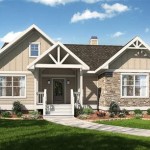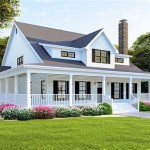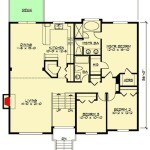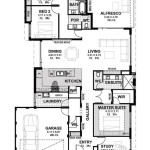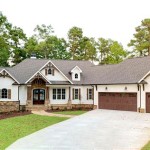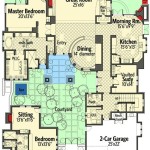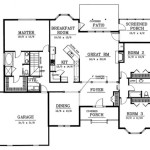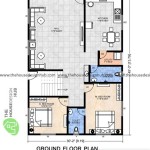Ranch Style Homes Floor Plans: A Comprehensive Overview
Ranch style homes, also known as ramblers, are characterized by their single-story layout, long, low-pitched roofs, and attached garages. This architectural style, originating in the United States during the 1930s, emphasizes simplicity, practicality, and an informal way of life. The popularity of ranch homes surged in the post-World War II era, driven by suburban expansion and the desire for affordable and easily maintained housing. Understanding the various floor plan options available within the ranch style is essential for prospective homeowners or those considering remodeling an existing ranch house.
The defining characteristic of a ranch house floor plan is its horizontal orientation. Rooms are typically spread out on a single level, minimizing the need for stairs. This design feature makes ranch homes particularly appealing to individuals with mobility issues and families with young children. Furthermore, the open-concept living spaces often found in ranch homes promote a sense of spaciousness and encourage social interaction within the family.
The evolution of ranch style homes has resulted in diverse floor plan variations. Early ranch houses often featured smaller footprints and more compartmentalized rooms. Contemporary examples, however, tend to incorporate larger square footage and emphasize open-plan living areas that seamlessly integrate the kitchen, dining room, and living room. The adaptability of the ranch style allows for customization to suit individual needs and preferences.
Key Features of Ranch Style Home Floor Plans
Ranch style homes are recognized by several recurring features that contribute to their distinctive aesthetic and functional appeal. These include single-story construction, attached garages, and a focus on indoor-outdoor living.
The single-story layout is arguably the most recognizable aspect of ranch homes. This design eliminates stairs, making the home accessible to people of all ages and abilities. It also streamlines the process of moving furniture and simplifies household chores. The lack of stairs can also create a more cohesive and unified living experience, connecting all parts of the house on a single plane.
Attached garages are a common feature of ranch homes, adding convenience and security. The garage provides shelter for vehicles and often includes additional storage space. Direct access from the garage to the interior of the house is another key benefit, particularly during inclement weather. In many ranch home floor plans, the garage is positioned at the front of the house, contributing to the overall horizontal aesthetic.
Many ranch style homes incorporate elements that promote indoor-outdoor living. Large windows and sliding glass doors are commonly used to connect the interior spaces to the surrounding landscape. Patios, decks, and porches are often integrated into the floor plan, providing opportunities for outdoor relaxation and entertainment. This connection to the outdoors is a defining characteristic of the ranch style, reflecting the desire for a relaxed and informal lifestyle.
Common Ranch Style Floor Plan Layouts
Several common floor plan layouts are found within the ranch style genre. These layouts can be broadly categorized as linear, L-shaped, U-shaped, and courtyard ranch homes.
The linear floor plan is the simplest and most common type of ranch home layout. In this configuration, the rooms are arranged in a straight line, typically with the living areas on one side and the bedrooms on the other. The hallway runs along the length of the house, providing access to all rooms. This layout is efficient and easy to navigate, but it can sometimes feel cramped if the hallway is too narrow.
The L-shaped floor plan features two wings that intersect at a right angle. This layout creates a natural separation between living areas and sleeping areas, offering increased privacy. The angle formed by the wings can also create a protected outdoor space, such as a patio or garden. L-shaped ranch homes often have a larger footprint than linear ranch homes, allowing for more spacious rooms and additional amenities.
The U-shaped floor plan is similar to the L-shaped plan, but with a third wing that encloses a central courtyard. This layout creates a private and sheltered outdoor space that can be used for relaxation, entertaining, or gardening. U-shaped ranch homes are particularly well-suited for warm climates, where outdoor living is a significant part of the lifestyle. The courtyard also provides ample natural light and ventilation to the interior spaces.
Courtyard ranch homes further emphasize the outdoor space component. These designs often feature rooms arranged around a central courtyard, creating a strong connection between the interior and exterior. The courtyard serves as an extension of the living space, providing a private and enclosed area for outdoor activities. Courtyard ranch homes are typically more expensive to build than other types of ranch homes due to their complex design and larger footprint.
Adaptations and Modernizations of Ranch Style Floor Plans
While the traditional ranch style home retains its appeal, numerous adaptations and modernizations have emerged to meet contemporary needs and preferences. These changes often involve incorporating open-concept living spaces, expanding the square footage, and adding modern amenities.
One of the most significant trends in ranch home design is the incorporation of open-concept living spaces. This involves removing walls between the kitchen, dining room, and living room to create a large, flowing space. Open-concept living promotes a sense of spaciousness and encourages social interaction. It also allows for greater flexibility in furniture arrangement and interior design. Modern ranch homes often feature large kitchen islands, which serve as both a workspace and a gathering place.
Another common adaptation is the expansion of the square footage. Traditional ranch homes were often relatively small, but modern ranch homes tend to be larger, offering more living space and additional amenities. This expansion can involve adding a second story or expanding the footprint of the house on a single level. Larger ranch homes often include features such as home offices, media rooms, and multiple bathrooms.
Modern amenities are also frequently incorporated into ranch style floor plans. These can include energy-efficient appliances, smart home technology, and updated finishes. Energy-efficient windows and insulation can help to reduce energy consumption and lower utility bills. Smart home technology, such as automated lighting and security systems, can enhance convenience and security. Updating the finishes, such as flooring, countertops, and cabinetry, can modernize the look and feel of the home.
Furthermore, accessibility is often a key consideration in modern ranch home design. Features such as wider doorways, grab bars in bathrooms, and ramps leading to the entrance can make the home more accessible to individuals with mobility issues. Universal design principles are often incorporated to create a home that is comfortable and functional for people of all ages and abilities.
The rise of the "modern farmhouse" aesthetic has also influenced ranch home design. This style combines the simplicity and functionality of the ranch style with the rustic charm of a farmhouse. Modern farmhouse ranch homes often feature shiplap walls, exposed beams, and reclaimed wood accents. The color palette is typically neutral, with shades of white, gray, and beige predominating.
Ultimately, the adaptability of the ranch style allows for endless possibilities in floor plan design. Whether one prefers a traditional layout or a more contemporary approach, the ranch style offers a versatile and practical option for homeowners.
When considering remodeling a ranch style home, it's crucial to consider the existing structure and how it can be adapted to meet modern needs. Opening up walls to create more open living spaces is a common renovation, but it's essential to ensure that the structural integrity of the house is maintained. Adding additional windows or skylights can also brighten up the interior and enhance the connection to the outdoors.
Another consideration for remodeling is the exterior appearance of the house. Updating the siding, roofing, and landscaping can dramatically improve the curb appeal of the home. Painting the exterior in a fresh, modern color can also make a significant difference. Adding a front porch or patio can create a welcoming and inviting entrance to the house.
Ranch style homes have proven their enduring appeal. Understanding the nuances of their floor plans, their adaptations, and their potential for modernization allows homeowners to create spaces that are both functional and aesthetically pleasing. The ranch style’s simplicity and practicality make it a versatile choice that can be adapted to a wide range of lifestyles and preferences.

House Plan 45467 Ranch Style With 1680 Sq Ft 4 Bed 2 Bath

Trending Ranch Style House Plans With Open Floor Blog Eplans Com

9 Best Open Floor Plans For Ranch Style Homes Deepnot Log Home House

Cool Ranch Style Homes For 2024 Blog Eplans Com

House Plan 51987 Ranch Style With 3366 Sq Ft 4 Bed 3 Bath 1

Ranch Style House Plan 2 Beds Baths 1092 Sq Ft 80 101 Plans Homes Floor

Tierney Ranch House Plans Luxury Floor

Pennwest Homes T Ranch Style Modular Home Floor Plans Overview Custom Built By Patriot S

Peach Tree House Plan Ranch Floor Designs

Ranch House Plans Floor Cool

